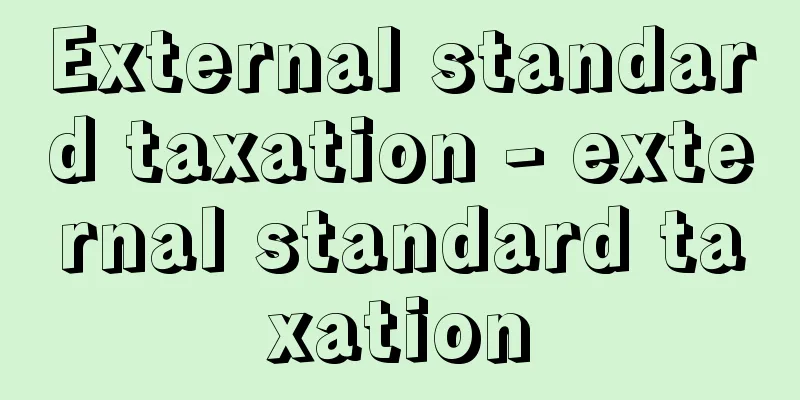Fixed assets - Koteishisan (English spelling) fixed assets

|
In corporate accounting, assets that a company uses or holds over a long period of time are called "fixed assets." They are different from fixed assets held by individuals. When classified on the balance sheet, assets are divided into current assets and fixed assets, but the main difference between them is that unlike current assets such as inventory and trading securities, companies do not intend to process or sell them directly, but hold them for a long period of time in the hope of earning income or profits through use in business activities or for investment purposes. One way in which they are contrasted with current assets is that they are assumed to be held for a long period of time, but the classification of current and fixed assets is done based on the operating cycle standard or the one-year standard, etc. Fixed assets are further classified into tangible fixed assets, intangible fixed assets, and investments and other assets (investments, etc.). Tangible fixed assets are business assets that have substance, such as buildings, equipment, machinery, land, and construction in progress accounts. Intangible fixed assets are assets that do not have a physical form, such as industrial property rights (=industrial property rights, such as patent rights, utility model rights, trademark rights, and design rights), leasehold rights, and rights to use dedicated sidings, which are legal rights, and "goodwill," which has the nature of excess profitability. Investments and other assets (investments, etc.) include shares in subsidiaries and affiliates, other securities, capital contributions, long-term loans, and long-term prepaid expenses, which have the nature of long-term funds invested by companies for the purpose of profit making. Regarding the end-of-period valuation of fixed assets, the acquisition cost is used as the basis, and depreciation procedures and impairment accounting valuation methods are applied over the accounting period during which the assets are held after acquisition. In addition, the main indicators used in management analysis to analyze fixed assets are the fixed ratio and the fixed long-term suitability ratio, which are used to measure financial stability. The fixed ratio is, [Noriyuki Chikada] "Accounting Practice for Fixed Assets" edited by Azsa & Co. (2009, Chuo Keizaisha) " "Knowledge of Fixed Asset Accounting" by Saburo Horiuchi (Nikkei Bunko) [Reference item] | | | | |Source: Shogakukan Encyclopedia Nipponica About Encyclopedia Nipponica Information | Legend |
|
企業が長期にわたり使用または保有する資産のことを企業会計上「固定資産」とよぶ。個人が保有する固定資産とは異なる。貸借対照表の表示上の分類として、流動資産と固定資産の区分があるが、そのおもな違いは、企業が棚卸資産や売買目的有価証券等の流動資産のように、加工もしくは直接的な売却を目的とせず、長期にわたり、営業活動における使用や投資目的において収益・利得の獲得を期待して保有するという点である。流動資産と対比される点の一つは長期にわたる保有を前提とする点であるが、流動・固定の分類は営業循環基準や1年基準等により行われる。 さらに、固定資産は、有形固定資産、無形固定資産、投資その他の資産(投資等)に分類される。有形固定資産は、実体を有する事業用資産であり、具体的には、建物、備品、機械、土地、建設仮勘定などがある。無形固定資産は、法律上の権利である工業所有権(=産業財産権。特許権、実用新案権、商標権、意匠権)、借地権、専用側線利用権などと、超過収益力の性格を有する「のれん(営業権)」からなる実体としての形を有しない資産である。投資その他の資産(投資等)には、企業が利殖を目的として投資をした長期資金の性格を有する子会社・関連会社株式やその他有価証券、出資金、長期貸付金、長期前払費用などがある。 固定資産の期末評価に関しては、取得原価による評価を基礎として、取得後保有する会計期間にわたり、減価償却による手続や減損会計による評価手法が適用される。また、経営分析の指標において固定資産を使って分析するおもなものには、財務の安全性をみるための固定比率と固定長期適合率がある。固定比率とは、 [近田典行] 『あずさ監査法人編『固定資産の会計実務』(2009・中央経済社)』▽『堀内三郎著『固定資産会計の知識』(日経文庫)』 [参照項目] | | | | |出典 小学館 日本大百科全書(ニッポニカ)日本大百科全書(ニッポニカ)について 情報 | 凡例 |
<<: Property Tax - Koteishisanzei
>>: Fixed exchange rate system
Recommend
《Strangers of the Amur Region》
…His major work, Travels and Explorations in the ...
Secret of the Foreigners
This is a collection of medicinal prescriptions us...
Schickard, W.
...This machine was used to perform multiplicatio...
Watercolor - Watercolor
Paintings made with paints dissolved in water. In ...
Gum arabic - Arabia gomu (English spelling) gum arabic
A natural resin made by drying the sap of the Aca...
Callidula attenuata (English spelling)
...The larvae feed on the leaves of the Dryopteri...
Bolesław Krzywousty
…[Miyajima Naoki]. … *Some of the terminology exp...
Osman - Osman
…While serving as a senator and judge as an arist...
Stone Guest - Ishi no Kyaku
…His orchestral work Kamarinskaya (1848) and the ...
tool
...It seems that it was Zen monks who made this w...
Physical education
It can mean the organization and systematization ...
akademische Freiheit (English notation) akademische Freiheit
...However, it was only as a result of historical...
Pinhole camera
Pinhole camera. A lensless camera with a small hol...
Short bill spearfish
...It is also called Sugiyama. Its English name i...
Acetaminophen
It is an aniline derivative that is an antipyretic...









